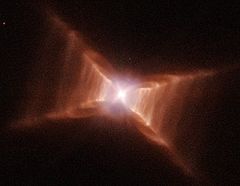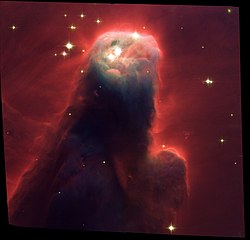Monoceros
Monoceros (Greek unicorn) is a constellation in the winter night sky of the northern hemisphere, surrounded by Orion to the west, Gemini to the north, and Canis Major to the south and Hydra to the east. Other neighboring constellations are Canis Menor, Lepus and Puppis.
Notable features
The constellation's brightest star is α Monocerotis, a yellow-orange giant ten times the size of the Sun located 144 light-years away. β Monocerotis is a multiple star that can be resolved with a small telescope. William Herschel discovered its multiplicity in 1781 and described it as "one of the most beautiful visions in the sky". It is made up of three almost identical bluish-white stars, the overall brightness of the system (+3.74) being greater than that of αMonocerotis.
Distant about 1000 light-years, ζ Monocerotis is a yellow supergiant of spectral type G2Ib (where the b” indicates that within this class it is one of the least luminous) with an approximate mass of 6.6 solar masses. Also supergiant—although type A0I—is 13 Monocerotis, whose luminosity is 17,000 times that of the Sun.
The constellation contains several variables of great interest. Thus, S Monocerotis (15 Monocerotis) is a massive binary system composed of two very hot stars —spectral type O7V and O9.5V— with an orbital period of 25 years. In this sense, the so-called Plaskett's Star (HD 47129) is one of the most massive binary systems known: each of the components can reach a mass close to 50 solar masses. R Monocerotis is also a massive but very young T Tauri star that is located at the end of the mixed emission and reflection nebula NGC 2261, also known as the "Hubble Variable Nebula". Likewise, V700 Monocerotis (MWC 147) is a young Herbig Be star that has not yet entered the main sequence and is accreting. For its part, V838 Monocerotis is a red supergiant that in 2002 suffered a major outburst whose origin is not well known.
Monoceros has several stars with extrasolar planets: HD 52265 —called Citalá— is a G0V-type yellow dwarf with a planet with a mass equal to or greater than that of Jupiter, while HD 46375 is a binary, around whose main component moves a planet that completes its orbit every 72.6 hours.
Near the boundary with Canis Major is the open cluster M50, discovered in 1772 by Charles Messier, although it was probably observed earlier by the Italian astronomer Giovanni Cassini; it is located 2,900 light-years from Earth and has a approximate age of 140 million years. NGC 2232 is another bright open cluster centered on the B2V type star 10 Monocerotis. It lies in the Gouldian belt at a distance of 1060 light-years.
The Rosette Nebula—which goes by various NGC designations such as 2237, 2238, 2239, and 2246—is a large, spherical HII region. The open cluster NGC 2244 (Caldwell 50) is closely associated with this nebula, having formed out of the surrounding gas only a few million years ago. Its two main stars are of spectral type O.
The name NGC 2264 comprises two different objects: the open cluster known as the Christmas Tree Cluster and the Cone Nebula. The nebula is seven light-years long and 2,500 light-years away. Two other objects, the Snowflake Cluster and the Fox Fur Nebula, are also encompassed within NGC 2264.
Similarly framed in Monoceros, NGC 2346 is a planetary nebula informally known as the Butterfly Nebula. At its center is a binary star whose orbital period is 16.00 ± 0.03 days. Likewise, the Red Rectangle Nebula is a planetary protonebula named for its characteristic shape and its apparent color from Earth. Discovered in 1973, the star HD 44179, also a binary, is located at its center. It is approximately 2,300 light years from us.
Main Stars
- α Monocerotis (Lucida / Ctesias), of visual magnitude 3,93, a giant yellow-orange star at 144 light years.
- β Monocerotis (Cerastes), impressive triple star system formed by three white-blue stars of magnitudes 4,7, 5,2 and 6,1, visible with the help of a small telescope.
- γ Monocerotis (Tempestris), of magnitude 3,98, also orange giant, but farther away than α Monocerotis.
- δ Monocerotis (Kardegán), white star of the main sequence of magnitude 4,15.
- ε Monocerotis, double star whose components, of magnitude 4,41 and 6,60, are separated 12.1 seconds of arc.
- Monocerotis, yellow supergiant of magnitude 4,37.
- 3 Monocerotis, binary star whose main component is a blue giant of magnitude 4.98.
- 13 Monocerotis, distant white supergiant 10.800 times brighter than the Sun.
- 19 Monocerotis, variable Beta Cephei of magnitude 4,99, also called V637 Monocerotis.
- 20 Monocerotis, an orange giant of magnitude 4,92.
- 25 Monocerotis, white-yellow giant of magnitude 5,14.
- 27 Monocerotis, an orange giant of magnitude 4,94.
- 28 Monocerotis (V645 Monocerotis), an orange giant of magnitude 4,69; it is a FK Comae Berenices variable.
- R Monocerotis, variable star immersed in a cloud of matter, located at the southern end of the NGC 2261 nebula.
- S Monocerotis (15 Monocerotis), distant blue star that forms part of NGC 2264.
- T Monocerotis, a strained variable whose magnitude varies between 5,58 and 6.62 in a cycle of 27 days.
- U Monocerotis, variable RV Tauri whose brightness varies between magnitude 6.1 and 8.8.
- W Monocerotis, carbon star of average magnitude 9,95; is an irregular variable.
- RV Monocerotis, semiregular variable, also carbon star.
- DD Monocerotis, ellipsing binary of magnitude 11,1.
- V700 Monocerotis (MWC 147), young star Herbig Ae/Be of 500 000 years old.
- V715 Monocerotis, light blue giant of magnitude 6,15.
- V789 Monocerotis, binary star composed of two orange dwarfs with intense chromosopheric activity.
- V838 Monocerotis, a star that suffered a large burst in 2002; it is located about 20 000 light years away.
- Plaskett Star (HR 2422), one of the most massive binary systems known.
- HD 45652, star of magnitude 8.13 that hosts a planetary system.
- HD 46375, orange subgigant star with an extrasolar planet of "hot flush".
- HD 50064, low studied blue hypergigante star.
- HD 52265, yellow dwarf analogous to the Sun around which a gas giant has been discovered.
- Ross 614 (V577 Monocerotis), red dwarf also in the vicinity of the Solar System.
- Gliese 250, binary star at 28.4 light years, composed of an orange dwarf and a red dwarf.
Deep Sky Objects
- M50 open cluster, with an estimated 200-star population in the main body, is about 2900 light years from the solar system.
- NGC 2232 is also an open cluster; with twenty stars, it is 1060 light years away. Other open clusters are NGC 2343, NGC 2349, NGC 2254—distant 7100 light years— and NGC 2506.
- Nebula Roseta (NGC 2237-9,46), a diffuse nebula next to the open cluster NGC 2244, whose stars have formed from the nebula material. The nebula, over 100 light years in diameter, has many Bok blood cells in its dark areas.
- Nebula or Monoceros loop, rest of ancient supernova adjacent to the Roseta nebula.
- Christmas tree cluster and Cone Nebula (NGC 2264), both objects are associated and are about 2500 light years away.
- NGC 2346, butterfly-shaped planetary nebula. At the center of this bipolar nebula is a spectroscopic binary star and ionization comes from the ultraviolet emission of the accompanying star.
- Nebula Red Rectangle (HD 44179), nebula protoplanettaria that when studied in detail by the Hubble space telescope shows a complex form of aspa instead of rectangular.
History
Monoceros is a modern constellation, named by the Dutch astronomer and theologian Petrus Plancius in 1613 and recorded by Jakob Bartsch as Unicorn in his star chart of 1624. However, Heinrich Wilhelm Olbers and Christian Ludwig Ideler indicate that the constellation is much older, listed as "the second horse south of the Twins and the Crab" in writings from 1564, and Joseph Justus Scaliger reports having found it in a sphere in ancient Persia.
Contenido relacionado
Astrophysics
Category:Jupiter
(176) Iduna





